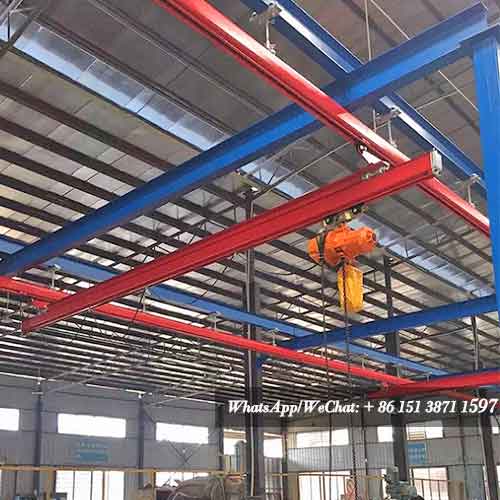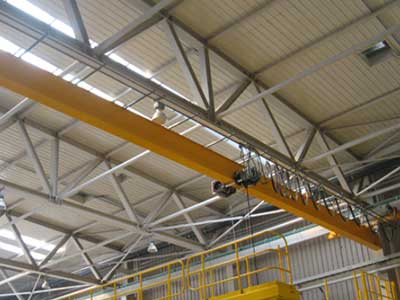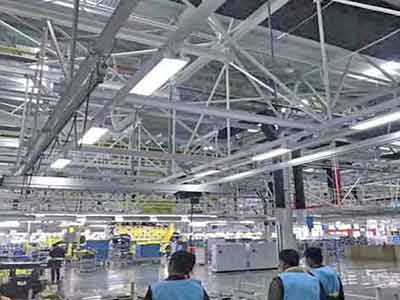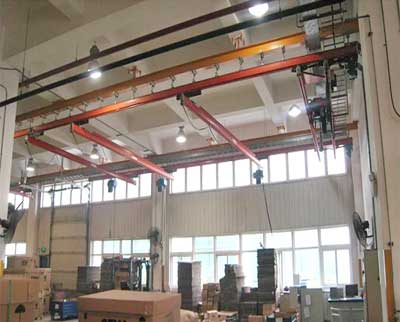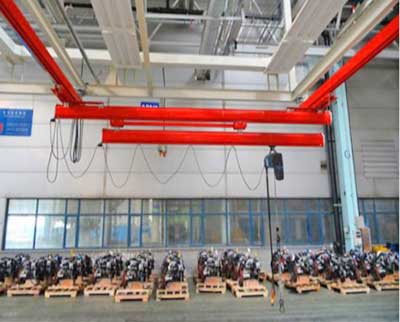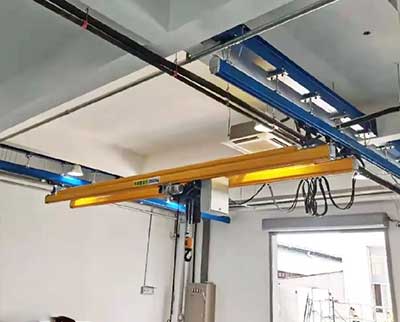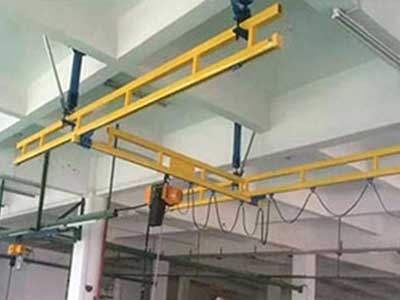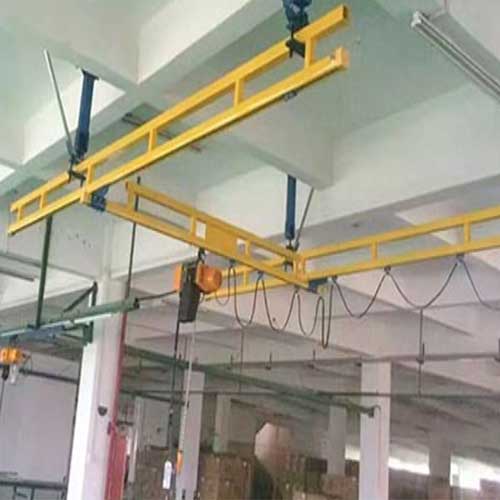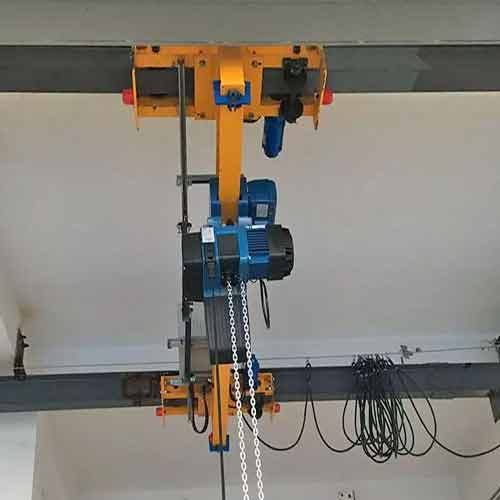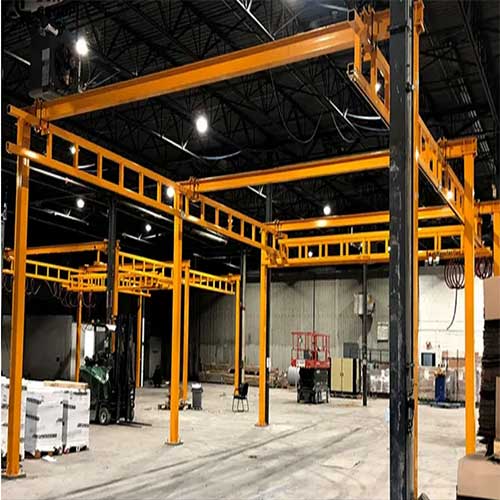Ceiling Mounted Workstation Crane 1 T, 2 T, 3 T Design & Benefit
Ceiling mounted workstation crane 1 ton, 2 ton, 3 tons for sale with unique features of modularity, ease of installation, ergonomic advantages. Check now.
Category: Ceiling Mounted Crane
Your Trusted Ceiling Mounted Crane Manufacturer & Supplier
Ceiling Mounted Workstation Crane 1 T, 2 T, 3 T Design & Benefit
Ceiling mounted workstation crane 1 ton, 2 ton, 3 tons for sale with unique features of modularity, ease of installation, ergonomic advantages. Check now.
In the bustling industrial landscape, the optimization of material handling processes is crucial for productivity and safety. Enter the ceiling-mounted workstation crane - a revolutionary solution that has transformed the way businesses handle loads within designated work areas. These versatile cranes, available in various load capacities such as 1 ton, 2 tons, and 3 tons, have revolutionized industrial operations by providing an efficient and ergonomic solution for lifting and moving loads within confined workspaces.
Ceiling Mounted Workstation Cranes:
Ceiling-mounted workstation cranes are precision-engineered material handling systems designed to facilitate the efficient movement of loads within specific work areas or assembly lines. These cranes are suspended from the ceiling structure of a facility, optimizing floor space and enabling precise load handling without interfering with ground-level operations.
At the heart of this exploration lies a keen interest in unraveling the benefits and applications of these versatile workstation cranes. By providing an in-depth analysis of their features and advantages, this article seeks to equip readers with the knowledge needed to make informed decisions when considering the implementation of ceiling-mounted workstation cranes within their facilities. Whether you're exploring options to optimize your assembly lines, improve material handling in maintenance workshops, or enhance efficiency in precision-driven environments, this comprehensive guide aims to navigate you through the diverse world of workstation cranes.
Understanding Ceiling Mounted Workstation Cranes
Definition and Components of Ceiling Mounted Workstation Cranes:
Ceiling-mounted workstation cranes stand as a pinnacle of efficiency in material handling systems. These cranes are comprised of several essential components working in unison to deliver precision and versatility within designated work areas. The main components typically include:
- Girder System: The core structural element providing support and stability for the crane. Depending on the load capacity and design, it can feature single or double girders.
- Hoist Mechanism: An integral part of the crane responsible for lifting and lowering loads. The hoist is available in various configurations to match different weight requirements.
- Trolley and End Trucks: The trolley, equipped with wheels, moves along the girder, while end trucks support and guide this movement, facilitating horizontal mobility.
Ceiling-mounted workstation cranes are available in diverse load capacities, offering solutions tailored to specific material handling needs. The different load capacities - 1 ton, 2 tons, and 3 tons - cater to a wide spectrum of industries, ranging from light-duty operations to heavier lifting requirements.
Overview of Modularity and Flexibility in Design:
One of the standout features of ceiling-mounted workstation cranes lies in their modularity and flexible design. These cranes are engineered with adaptability in mind, allowing for customization based on the unique demands of various industrial applications. Whether it's configuring the girder layout, adjusting the hoist mechanism, or designing a specific runway system, the modularity of these cranes enables seamless adaptation to different work environments.
The flexibility inherent in the design ensures that businesses can efficiently utilize the available workspace while optimizing the material handling process. This adaptability is particularly beneficial in industries where workflow dynamics often evolve or when operations demand precision handling within confined areas.
Ceiling-mounted workstation cranes' modular and flexible design not only enhances their versatility but also allows for easier installation and future modifications, ensuring that businesses can adapt to changing needs without significant disruption.
Design Features of 1 ton, 2 ton, and 3 ton Workstation Cranes
Single/Dual Girder Configuration:
- 1 ton Cranes: Typically designed with a single girder configuration, offering efficient load handling capabilities for lighter materials without compromising on stability.
- 2 ton and 3 ton Cranes: Often equipped with dual girder configurations to accommodate heavier loads. Dual girders enhance stability and load-bearing capacity, allowing for precision handling of materials.
Hoist Mechanism:
- 1 ton Cranes: Equipped with compact hoist mechanisms optimized for lighter loads, ensuring precise lifting and lowering within designated work areas.
- 2 ton and 3 ton Cranes: Feature robust hoist mechanisms capable of handling heavier materials while maintaining precision and control during lifting operations.
Runway System:
- 1 ton Cranes: Employ a lighter-duty runway system, designed to support the crane's movement while optimizing space within the work area.
- 2 ton and 3 ton Cranes: Utilize a sturdier runway system, capable of bearing heavier loads and ensuring smooth and stable crane movement across the designated workspace.
Trolley and End Trucks:
- 1 ton Cranes: Equipped with trolleys and end trucks that are lighter in build, allowing swift and controlled lateral movement within the work area.
- 2 ton and 3 ton Cranes: Utilize robust trolleys and end trucks designed to handle heavier loads, providing stability and precise control during horizontal movements.
The design features of the 1 ton, 2 ton, and 3 ton workstation cranes are tailored to suit various load capacities, ensuring optimal efficiency and safety in material handling operations within specific industrial settings.
Benefits of Different Capacity Workstation Cranes
Workstation cranes, tailored to varying load capacities of 1 ton, 2 tons, and 3 tons, offer an array of advantages catering to diverse industrial needs:
Modularity and Customization for Specific Load Requirements:
- 1 ton Cranes: Designed for lighter loads, these cranes offer precision and flexibility, allowing businesses to efficiently handle materials without overburdening the system.
- 2 ton and 3 ton Cranes: With higher load capacities, these cranes provide the versatility required for heavier material handling operations, ensuring robustness and reliability while lifting substantial loads.
The modular design of workstation cranes enables businesses to customize the system according to specific load requirements, ensuring optimal performance without unnecessary strain.
Ease of Installation and Adaptability to Different Workspaces:
- 1 ton Cranes: Being lighter in structure, these cranes are comparatively easier to install and integrate into different workspace configurations, offering adaptability without compromising efficiency.
- 2 ton and 3 ton Cranes: Despite their heavier load capacities, modern engineering ensures that these cranes are installed efficiently, adapting seamlessly to varying workspace constraints while maintaining operational excellence.
Workstation cranes, regardless of their load capacities, are designed to maximize workspace utilization and facilitate smooth material handling operations within confined areas.
Ergonomic Advantages for Improved Workplace Safety and Efficiency:
- 1 ton Cranes: Ideal for tasks requiring precision and ergonomics, contributing to improved workplace safety and reducing the risk of strains or injuries during material handling tasks.
- 2 ton and 3 ton Cranes: Ensuring ergonomic lifting and movement of heavier materials, these cranes enhance workplace safety and efficiency by minimizing manual handling risks.
The ergonomic design of workstation cranes, coupled with their load-specific capacities, significantly improves operational safety, promoting a safer and more efficient work environment.
Applications and Industries
Industries Benefitting from 1 ton, 2 ton, and 3 ton Workstation Cranes
Ceiling-mounted workstation cranes with load capacities of 1 ton, 2 tons, and 3 tons find extensive applications across various industries, providing tailored solutions for specific material handling needs:
Manufacturing and Assembly Lines:
- 1 ton Cranes: In manufacturing facilities, these cranes are ideal for precision handling of smaller components or parts in assembly lines, enhancing efficiency and streamlining production processes.
- 2 ton and 3 ton Cranes: Well-suited for heavier lifting requirements in manufacturing, these cranes facilitate the seamless movement of larger components or machinery during assembly processes, ensuring precision and safety.
Maintenance Workshops:
- 1 ton Cranes: These cranes excel in maintenance workshops, aiding technicians in the handling of lighter equipment or tools, contributing to smoother and safer maintenance operations.
- 2 ton and 3 ton Cranes: With their higher load capacities, these cranes effectively lift and position heavier machinery or parts, supporting maintenance teams in critical repair tasks within workshops.
Laboratories and Precision Handling Environments:
- 1 ton Cranes: In laboratories or precision handling environments, these cranes offer the precision required for delicate tasks, aiding in the safe movement of sensitive equipment or materials.
- 2 ton and 3 ton Cranes: While maintaining precision, these cranes handle heavier instruments or machinery, ensuring the safe and accurate handling of materials in precision-driven environments.
The versatility and load-specific capacities of workstation cranes make them indispensable across industries, supporting various material handling operations and contributing to enhanced efficiency and safety within specific work environments.
Comparison between Different Capacity Workstation Cranes
Load Capacity and Flexibility:
- 1 ton Cranes: Ideal for lighter loads, offering precise handling and flexibility in confined workspaces without compromising on stability or efficiency.
- 2 ton and 3 ton Cranes: With higher load capacities, these cranes cater to heavier lifting requirements, ensuring robustness and reliability while accommodating larger loads.
Suitability for Various Industrial Applications:
- 1 ton Cranes: Primarily suited for tasks demanding precision handling in industries such as laboratories, maintenance workshops, and assembly lines requiring delicate part manipulations.
- 2 ton and 3 ton Cranes: Versatile solutions catering to a broader range of industries including manufacturing, heavy assembly operations, and maintenance tasks involving larger equipment or machinery.
Cost-Efficiency and Return on Investment:
- 1 ton Cranes: Economical options suitable for specific tasks, providing a cost-effective solution for businesses focusing on precision handling and light-duty applications.
- 2 ton and 3 ton Cranes: While slightly higher in initial investment, these cranes offer increased load capacities, ensuring a higher return on investment by accommodating a wider range of materials and tasks.
Comparing these capacities allows businesses to make informed decisions based on their specific material handling requirements and budget constraints.
Case Studies or Examples
Real-life Examples Showcasing Successful Implementation
Implementing workstation cranes has proven instrumental in various industries, optimizing material handling operations and elevating workplace efficiency. Here are some real-life case studies illustrating the successful utilization of different capacity workstation cranes:
Precision Handling in Laboratories - 1 ton Cranes:
Case Study: A renowned research laboratory implemented 1 ton workstation cranes to handle sensitive scientific equipment and materials. The cranes facilitated precise movement and ensured the safe handling of delicate instruments, contributing to improved research workflows.
Streamlining Assembly Processes - 2 ton and 3 ton Cranes:
Case Study: An automotive manufacturing plant integrated 2 ton and 3 ton workstation cranes into their assembly lines. These cranes efficiently handled heavy vehicle components, reducing assembly time and enhancing productivity.
Testimonials or Reviews from Industries Using Different Capacity Workstation Cranes
Testimonial from a Laboratory Manager:
"The 1 ton workstation crane revolutionized our laboratory operations. Its precision handling capabilities significantly improved the safety and efficiency of our experiments." - Laboratory Manager,
Testimonial from a Manufacturing Facility Manager:
"Our investment in 2 ton and 3 ton workstation cranes proved invaluable. They allowed us to handle larger components seamlessly, contributing to smoother assembly processes and increased output." - Facility Manager, ABC Automotive Manufacturing
Installation Considerations and Maintenance
Factors to Consider during Installation
Proper installation of workstation cranes is pivotal for their efficient functioning. Consider the following factors during the installation process:
- Structural Evaluation: Before installation, assess the building's structure to ensure it can support the crane's weight. This evaluation ensures safety and prevents structural issues.
- Workspace Optimization: Plan the crane layout to optimize space and workflow efficiency. Consider factors like clearances, obstruction-free movement, and material flow to maximize the crane's utility.
- Compliance with Safety Standards: Ensure compliance with safety regulations and standards during installation. It includes proper anchoring, electrical connections, and adherence to load-bearing specifications.
Maintenance Practices for Prolonged Lifespan and Efficiency
- Regular Inspections: Schedule routine inspections to check for wear, misalignment, or damage in components. Addressing issues early prevents larger problems and ensures smooth operations.
- Lubrication and Cleaning: Keep all moving parts well-lubricated and clean. This prevents corrosion, reduces friction, and ensures the longevity of the crane components.
- Training and Safety Measures: Train operators in correct usage and safety protocols. Encourage reporting of any malfunction or irregularities for immediate attention.
- Manufacturer Guidelines Adherence: Follow manufacturer guidelines for maintenance schedules and procedures strictly. Adhering to these recommendations maximizes efficiency and longevity.
Conclusion
Ceiling-mounted workstation cranes, available in varying capacities of 1 ton, 2 tons, and 3 tons, stand as versatile solutions revolutionizing material handling operations across diverse industries. As we conclude this exploration, let's recap the essence of these cranes and their significance:
Benefits of Different Capacity Workstation Cranes:
From their inception, these cranes have showcased a multitude of advantages tailored to specific industrial needs. Whether it's the precision handling capabilities of 1 ton cranes, the robustness of 2 ton and 3 ton cranes for heavier loads, or their modular design offering customization, each capacity brings distinct advantages to the table.
- Emphasis on the Versatility and Efficiency: The versatility and efficiency of these cranes are unparalleled. They streamline assembly processes, facilitate precision handling in laboratories, and optimize maintenance tasks, contributing significantly to workplace productivity and safety.
- Encouragement for Readers to Consider Suitability: For businesses seeking enhanced material handling capabilities, these workstation cranes present an array of benefits. It's imperative to evaluate the specific industrial requirements and match them with the appropriate load capacity crane to maximize operational efficiency and safety.
As we conclude this comprehensive guide, we hope the insights provided aid in understanding the diverse capacities and benefits of ceiling-mounted workstation cranes. These engineering marvels have transcended mere material handling tools to become indispensable assets in various industries, elevating operational standards and contributing to safer, more efficient work environments.
Should you have further inquiries or require guidance on selecting the ideal workstation crane for your industrial needs, consider consulting with experts in the field for tailored solutions and optimal outcomes.
Main Projects
Related Products

Supplied three grab bucket crane kits to Indonesia, enhancing garbage handling efficiency with high load capacity and reliable performance.
Free consultation to Confirm Parameters & Specifications and Get
Latest Crane Price & Crane Rate.
- Types of overhead cranes : _______?
- Optional: Overhead travelling crane, goliath gantry crane,Slewing jib crane, Single girder or double girder crane,small portable crane or kbk crane, etc.
- Capacity of overhead crane: _______?
- Optional: 0.25ton, 0.5 ton, 1 ton, 2 ton, 3ton, 5 ton, 10 ton,15ton, 20ton, 25 ton, 30ton,35ton, up to 550ton, etc.
- Crane span & lifting height : _______?
- Crane travelling length : _____?
- Control of overhead crane:_______?
- Optional: pendant/ remote/cabin control
- Voltage supply of overhead crane:_____?
- Eg,: 380V50/60HZ,3Phase or others,etc.
- Application/usage of crane:_______?
- Eg,: Steel mill, ,injection mold, cement,stone, concrete,granite, general manufacturing, etc.
Just leave a message via the contact form and our hoist and crane engineer will contact you with in 24working hours.
Get In Touch
